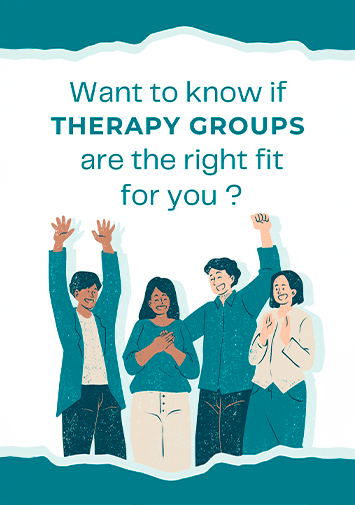EMDR stands for Eye Movement Desensitization and Reprocessing. That’s a mouthful, huh? Well, it’s not as complicated as it sounds. I promise.
What Is EMDR?
Although EMDR involves many things, the goal is to deal with emotional trauma and other distressing life experiences. Trauma and other negative past experiences can lead to a host of negative emotions and behaviors. In most forms of psychotherapy, there is a lot of talking. However, with EMDR, talking is more limited.
Many clients have found that they prefer EMDR because they don’t have to verbalize their thoughts or emotions. Furthermore, EMDR uses different techniques, so it is not focused on reliving the trauma. In fact, you and your therapist will design tools to use when things get intense in order to help you feel emotionally safe. And, please know that you can always stop whenever you want.
EMDR and The Brain
Something that makes EMDR unique is its use of bilateral stimulation. This technique involves alternating eye movements, sounds, or taps. These movements will be guided by your therapist. Bilateral stimulation is designed to aid the brain in resolving unprocessed traumatic memories. It helps connect parts of the brain that have been disconnected due to trauma. In turn, forming connections and clearing up any disconnections hindering the brain from its natural healing process. EMDR is an effective way to help your brain appropriately digest and store past experiences.
Our brains are very effective at managing stressful events. However, there are times when experiences are managed without actually being processed. This can be problematic as the stress from the experience remains in the body. When emotions are stored in the body due to being unprocessed, they can cause overwhelming feelings. And, these feelings can come up at an unexpected time.
EMDR helps your brain process these memories and feelings, absolving you of any stress-inducing feelings. The goal of EMDR therapy is to guide you toward creating healthier emotions, understandings, and perspectives attached to a traumatic experience. Consequently, you will be able to create healthy habits and behaviors instead of the unhealthy ones used to cope with the past.
Phases of EMDR Therapy
So what happens in EMDR? You can expect your EMDR therapy sessions to follow a relatively predictable path. Therapists who provide EMDR must be trained and certified to provide this therapy. This means that the process is not only standard but proven to work.
1. Introduction/Treatment Planning
Your therapist will begin by talking with you about your history and starting to identify the specific issues causing you distress. You will discuss your traumas and triggers that bring you to counseling. Then, you will determine which skills or behaviors you will need to learn for future well-being.
2. Preparation
The main goal of this phase is to build trust between you and your therapist. And to develop the tools you will need during EMDR therapy to cope when triggers arise. These tools will help you if and when you feel overwhelmed in an EMDR therapy session.
3. Assessment
In this phase, you will be asked to access each target memory so it can be effectively processed. A target memory is one that has been identified as traumatic or triggering for you. Furthermore, “processing” does not mean talking about it. Rather, it is about experiencing the past while in the present. You will be asked to:
- Bring up an image of the worst part of the memory
- Identify the negative belief associated with that memory
- Discuss the level of current distress
An important part of this stage is that you will identify and then replace negative beliefs associated with a memory. Not only will you gain understanding about that belief, but you will replace it with a healthier, more positive one.
For example, you may have the thought “I’m unworthy” due to something from your past. So, you will learn to replace it with “I’m a good person who is worthy of good things.” Logically, you may understand that your initial thought is untrue. However, without intentionally replacing the memory, your true feelings about yourself may not change.
4. Desensitization
This phase focuses on identifying and processing disturbing bodily sensations or emotions. It deals with all of your responses including other memories, insights, and associations that may arise.
5. Installation
The installation phase is about strengthening the positive affirmation you want to solidify in your mind. It helps you convince your body and emotions of the logical factors that your mind already knows to be true.
6. Body Scan
You will be asked to bring up the original disturbing memory to see if there is any residual body tension. If you still have unresolved concerns or issues, this scan will help identify those remaining needs.
7. Closure
Your therapist will guide you through self-calming techniques. Calming techniques can help you leave the session in a more positive frame of mind than when you begin. You should not leave an EMDR therapy session feeling more traumatized. Rather, you should leave the session feeling calmer, more in control, and better prepared to face any challenges that may come your way.
8. Reevaluation
Your therapist will reassess where you are in your treatment and how you have been responding.
Common Questions About EMDR
1. How long does EMDR take to work?
EMDR can be highly effective. For many clients, the course of EMDR is shorter than with traditional psychotherapy. For those who have experienced a “single-event trauma,” EMDR may only take 8-12 sessions. Examples of “single-event traumas” are a car accident, a school shooting, a devastating injury, or a one-time rape.
Although EMDR therapy may produce results more rapidly than previous forms of therapy, speed is not the focus. In fact, it is important to remember that every client has different needs. For instance, one client may take weeks to establish sufficient feelings of trust (Phase 2), while another may proceed quickly through the first six phases of treatment only to reveal something even more important that needs treatment.
So remember, each individual undergoing EMDR therapy is unique. So, the length of time you work with an EMDR therapist will depend on the severity and depth of your trauma. However, most patients continue to see results for months and even years after EMDR treatment.
2. What kinds of things does EMDR help with?
EMDR was initially designed to treat post-traumatic stress disorder (PTSD) for veterans but is now used to treat many conditions. Furthermore, this therapy is helpful for anyone that has experienced a traumatic experience (single event or prolonged) that had an impact on life functioning. We use EMDR to help address:
- Post-traumatic stress disorder
- Attachment-based issues
- Anxiety
- Emotional, psychological, physical, or sexual abuse
- Witnessing violence in the home
- Emotional neglect
3. Does virtual EMDR work?
Virtual EMDR therapy has shown to be equally as effective as in-person treatment. You can still benefit from sessions while in the comfort of your own home. This service is available to anyone in the state of Maryland.
Start EMDR Therapy in Baltimore, MD
Working with an EMDR therapist can help you resolve past trauma and live life more presently. So, the therapists at our counseling center located in Baltimore, MD are ready to meet with you and help you move forward. If you’re ready to begin EMDR therapy, follow the steps below.
- Request an appointment with us.
- Meet with a skilled EMDR therapist.
- Start healing from the past and moving forward with life.
Other Services at New Connections Counseling Center
The therapists at our Baltimore, MD-based counseling center understand the pain that traumatic memories can play in our lives, even after the fact. So, we offer EMDR therapy to help you move past trauma. Furthermore, we offer a variety of therapeutic services to help, such as anxiety treatment, therapy for depression, and counseling for life transitions. Additionally, we provide individualized services for both men and women, along with couples therapy, too. Plus, you can access any of our services virtually using online therapy in Maryland.






